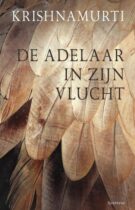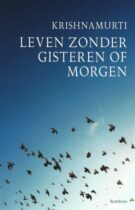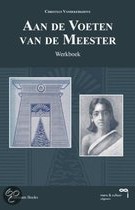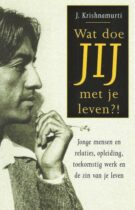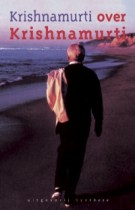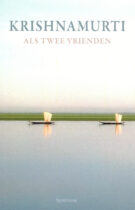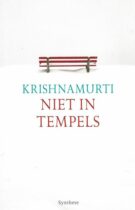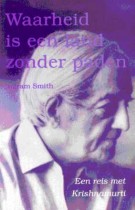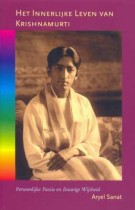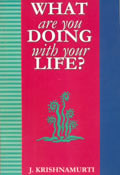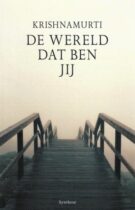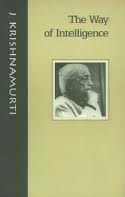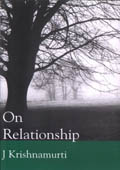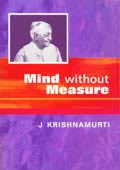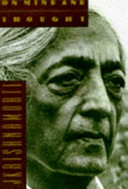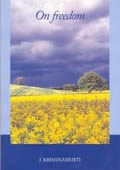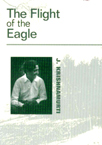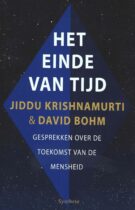A Jewel on a Silver Platter – Remembering Jiddu Krishnamurti
By Padmanabhan Krishna with a Foreword by Ravi Ravindra.
417 Pages | First printing Spring 2015 | Hardcover | Peepal Leaves Publisher | ISBN: 9781312903333.
This book gives an intimate portrayal of the philosopher sage Jiddu Krishnamurti by several of his colleagues, who knew him over many decades and interacted with him closely. It reveals several aspects of the man and investigates his teachings in depth.
The author, Padmanabhan Krishna, was a Professor of Physics and was closely associated with him for nearly three decades. He has lectured all over the world and conducted dialogues about Krishnamurti’s teachings.
From Chapter 20 – ‘What is Right Action’? (p. 351):
” So the Buddha’s action in leaving his wife and children and going into the forest would be right if he did it out of love and compassion for humanity; and the same action would be wrong if he did it for egoistic reasons, because he wanted to get away from his responsibilities. The quality of the mind taking that decision determines whether it is a right or a wrong decision. […] Because there is no self-interest in that consciousness, there is no partiality for the ‘me’ and the ‘mine’. Krishnamurti expressed it in another way; he said: ‘Come upon love, then do what you will’. Then one does not have to think and calculate and so on. But we must understand what he means by ‘love’. To him, ‘Love is where the self is not’. He is not talking about romance or attachment or sentiment as love. Only when self-interest is not the motivation, is there love. “
Aantekeningen
Door Jiddu Krishnamurti (1895 – 1986), vertaald door Hans van der Kroft, Thecla de Waal en Anneke Korndörffer.
367 Pagina’s | Eerste druk 1981, 2de uitgebreide druk 2004, 3de herziene druk 2018 | Softcover | Synthese, een imprint van Milinda Uitgevers B.V. | ISBN: 9789062711499.
Engels origineel: Krishnamurti’s Notebook | Copyright 1976, 2003 (full text edition) | Krishnamurti Foundation Trust, Ltd., Hampshire, England | ISBN: 9781888004632.
Krishnamurti’s Notebook is geen gewoon dagboek, maar een verzameling persoonlijke notities, die Krishnamurti maakte vanaf 18 juni 1961 tot 23 januari 1962, tijdens zijn reizen en zijn verblijf in Amerika, Engeland, Frankrijk, Zwitserland, Italie en India. Op 323 met de hand geschreven en door hemzelf genummerde pagina’s beschrijft hij in dichterlijk proza de beweging van de wolken, de wind, de bomen, het licht, de vogels en de extatische eenheidsbeleving, die hij in deze natuurverschijnselen ervaart. Meditatie, kun je volgens Krishnamurti niet methodisch opwekken, maar is een explosie van ‘gewaar-zijn’ op het moment, waarop je denken stil is en je de feiten ziet zonder ze te willen veranderen.
Afkomstig van blz. 21:
” Het heilige heeft geen attributen. Een steen in een tempel, een beeld in een kerk, een symbool – ze zijn niet heilig. De mens noemt ze heilig, iets dat gewijd is om te worden aanbeden uit gecompliceerde driften, angsten en verlangens. Die ‘heiligheid’ ligt nog in het vlak van het denken; ze is door het denken opgebouwd en in het denken ligt niets nieuws of heiligs. “
Waarheid is een Land zonder Wegen
Door Jiddu Krishnamurti (1895 – 1986), vertaald door May Verheyen.
175 Pagina’s | Copyright 1954, Nederlandse vertaling 2014 | Softcover | BBNC Uitgevers, Amersfoort | ISBN: 9789045316895.
Engels origineel: On Truth | Published in 1954 | Krishnamurti Foundation of America | ISBN: 978-0062510129.
‘ Religie betekent het onverschrokken verkennen, sceptisch bevragen en onderzoeken wat waarheid is. Dat is religie. – Ojai, 2 mei 1981. ‘
Waarheid is een Land zonder Wegen daagt de lezer uit tot zelfonderzoek en dialoog. Waarom zouden we ons druk maken om wegen, om waarheid om wat anderen zeggen, vraagt Krishnamurti ons in een van de vele diepgaande gesprekken, die dit boek rijk is. Waarom maak je het niet voor jezelf uit? En hoe doe je dat?
Zien wat er feitelijk is, wat zich op dit moment voordoet, is het enige waar het op aankomt, volgens Krishnamurti. Of het nu gaat over economische, sociale, religieuze, politieke of psychische vraagstukken, ontdek wat is – en vergeet wat zou moeten zijn. Ons grote struikelblok is het verlangen naar veiligheid, naar iets wat volmaakt bevredigend is en beklijft. En als er geen veiligheid blijkt te bestaan, houden we onszelf voor dat we op weg zijn naar de waarheid, Terwijl waarheid, zo oppert Krishnamurti, misschien eerder is als in een boot zitten zonder roeispaan – we ontdekken, bewegen, leren, blijven gaande.
Uit: ‘Bombay 12 maart 1950’ (blz. 35):
” Waarheid vind je niet door boeken, vrome toewijding of zelfopoffering: waarheid leer je kennen wanneer de geest vrij en kalm is. En die vrijheid, die kalmte van de geest komt alleen wanneer de feiten van zijn relaties begrepen worden. Zonder dat begrip leidt wat de geest ook doet, alleen maar tot meer problemen. Maar een geest, die vrij is van al zijn projecties kent een staat van kalmte, waarin alle problemen zijn verdwenen, en alleen dan wordt het tijdloze, het eeuwige geboren. Waarheid is dan niet langer een kwestie van kennis, niet iets wat je je moet herinneren of wat je moet herhalen, niet iets om te laten drukken en in het buitenland te verspreiden. Waarheid is dat wat ‘is’. Waarheid heeft geen naam en daarom heeft de geest er geen toegang. “
De Adelaar in Zijn Vlucht
Door Jiddu Krishnamurti (1895 – 1986), vertaald door Henri W. Methorst en A.J.G. Methorst-Kuiper.
221 Pagina’s | Eerste druk 1974, tweede druk 2015 | Synthese, een imprint van Milinda Uitgevers B.V. | ISBN: 9788187326366.
Engels origineel: The Flight of the Eagle | Published in 1972, 2005 edition | Krishnamurti Foundation, London, England | ISBN: 9781596750012.
‘ De adelaar laat in zijn vlucht geen spoor na; de man van de wetenschap wel. Als we het probleem van de vrijheid onderzoeken, hebben we niet alleen de wetenschappelijke benadering nodig, maar ook de vlucht van de adelaar, die geen spoor achterlaat! ‘
In De Adelaar in zijn Vlucht zijn twaalf toespraken samengebracht, die Krishnamurti in 1969 hield in London, Amsterdam, Parijs en Saanen. Als een adelaar scheert hij van de ene Europese hoofdstad naar de andere en overal vertolkt hij de kern van zijn boodschap: de oplossing van het menselijke problemen als angst, geweld en verdeeldheid ligt in het begrijpen van het probleem. Het antwoord ligt niet buiten de vraag, maar ligt in de vraag zelf besloten. We zijn echter zo gericht op het vinden van antwoorden, dat we ons geen nauwkeurig beeld kunnen vormen van het probleem, waardoor we een echte oplossing zelf in de weg zitten.
Velen beschouwen de adelaar in zijn vlucht als een van de belangrijkste publicaties van Krishnamurti. Het behandelt essentiële thema’s als vrijheid, verandering, geweld, vrede en de openheid voor het onbekende.
Afkomstig uit Hoofdstuk 1 – ‘Vrijheid; Denken, Genot en Leed’ (blz. 12):
” Wat is angst? (Neem vooral, als ik die suggestie mag geven, niet zomaar aan wat de spreker zegt, hij heeft geen enkel gezag, hij is geen leraar, geen goeroe. Want als hij een leraar was, waren jullie zijn volgelingen en als jullie zijn volgelingen waren, richtten jullie jezelf zowel als de leraar te gronde). We proberen erachter te komen wat de waarheid is in dit probleem van de angst en dat wel zo volledig, dat de geest nooit meer angstig zal zijn en daardoor innerlijk, psychisch, vrij is van al het afhankelijk zijn van een ander. Het mooie van vrij zijn is dat je geen spoor achterlaat. “
Leven zonder Gisteren of Morgen
By Jiddu Krishnamurti (1895 – 1986), vertaald door Hans van der Kroft.
174 Pages | Eerste druk 2015 | Synthese, een imprint van Milinda Uitgevers B.V. | ISBN: 9789062711185.
Engels origineel: As One is: To Free the Mind of All Conditioning | 2007 edition | Krishnamurti Foundation Trust Ltd., Hampshire, England | ISBN: 9781890772628.
‘Als je wilt ontdekken wat waarheid is, moet je volkomen vrij zijn van alle religies, van alle conditioneringen, van alle dogma’s, van alle vormen van geloof, van iedere vorm van gezag dat erop gericht is dat je je aanpast, wat in wezen betekent dat je totaal alleen staat en dat is heel moeilijk . . . ‘
Met Leven zonder Gisteren of Morgen verschijnen voor het eerst in het Nederlands acht toespraken, die Krishnamurti hield in 1955 in Ojai, Californië. In het eerste decennium na de Tweede Wereldoorlog spreekt hij wereldwijd voor een zeer geïnteresseerd publiek dat – geraakt door de stoffelijke en geestelijke verwoestingen van de oorlog en gericht op een nieuwe toekomst – openstaat voor frisse ideeën en nieuwe idealen, die helpen die toekomst vorm te geven.
Onder het loof van de altijdgroene eikenbomen in Ojai, bespreekt Krishnamurti uiteenlopende thema’s: de betekenis van dromen, toenemende jeugdcriminaliteit, het leven na de dood, opvoeding enz.; heel concrete onderwerpen waar men niet alleen toen, maar ook nu nog steeds mee worstelt. In de roes van de wederopbouw klinkt echter ook zijn kritische stem: progressie op het gebied van de productiviteit, wetenschap en techniek betekent niet automatisch vooruitgang in de richting van innerlijke vrijheid. Alleen wie scherp de eigen conditioneringen onderzoekt, is in staat zich aan de tredmolen van illusies te onttrekken en in vrijheid te leven.
Afkomstig van blz. 154:
” Vrij zijn van de samenleving betekent niet ambitieus zijn, niet hebzuchtig, niet prestatiegericht, het houdt in dat je niets bent in betrekking tot die samenleving, die ernaar streeft iets te zijn. Maar zie je, het is heel moeilijk dat te accepteren, want je kunt onder de voet gelopen worden, je kunt aan de kant gezet worden, je zult niets hebben. In dat niets heerst geestelijke gezondheid, niet in dat andere . . . Zolang je deel wilt uitmaken van deze samenleving, ben je onvermijdelijk medeoorzaak van waanzin, oorlogen, vernietiging en ellende, maar om je te kunnen bevrijden van deze samenleving – de samenleving van het geweld, van de rijkdom, van een goede positie, van het succes – heb je geduld nodig, moet je op onderzoek gaan, moet je ontdekkingen doen, geen boeken lezen, niet achter leraren, psychologen, enzovoort aan gaan. “
Education as Service
By Jiddu Krishnamurti (1895–1986).
116 Pages | Second edition, second reprint 2010 | Hardcover | The Theosophical Publishing House, Adyar | ISBN: 9788170594826.
” The office of the teacher is the most sacred and the most important to the nation, because it builds the characters of boys and girls, who will be its future citizens. “
So declared the world-renowned spiritual Teacher, J. Krishnamurti, when at the age of seventeen he wrote this book. In his previous valuable little work At the Feet of the Master, written when he was fourteen, he made available to the world the instructions he received from his Master on the four Qualifications for the spiritual path – Love, Discrimination, Desirelessness and Good Conduct. Here, the author shows how they can be applied to the life of the teacher and the student, and be of universal benefit.
From page 113:
” You must trust yourself. You say you know yourself too well. If you feel so, you do not know yourself; you know only the weak outer husk, which has fallen often into the mire. But you – the real you – you are a spark of God’s own fire, and God, who is almighty, is in you, and because of that there is nothing that you cannot do if you will “
Centred Self Without Being Self-Centred – Remembering Krishnamurti
20 Pages | First edition, 2010 | Paperback | Theosophical Publishing House, Adyar
Jiddhu Krishnamurti (1895 – 1986), like all true Rishis and Philosophers, based his saying on seeing. With him the emphasis was always on perception rather than thinking. Almost in every engagement – even in personal conversations this was often the case – sometimes practically in the middle of a sentence he would say, ‘Now listen to the birds‘ or ‘Look at the clouds‘. The mind which had been trapped in arguing or putting two and two together, would thus be invited to look. One was literally brought back to one’s senses.
“I was particularly moved by the scope, insight, and intimacy of this. I think you say things about Krishnamurti that are very true but not generally understood. I also think you go a long way to dispel some of the inevitable mythology that accrues, in time, to any teacher, mentor, or charismatic ‘religious’ figure. This is especially important as regards Krishnamurti. I realize how much there is in this and how truly wonderful it is.” — Alan Kishbaugh, the Executive Director of the Krishnamurti Foundation of America from 1998-2002 Excerpt: As Krishnamurti often emphasized, only a still mind can be attentive. There is a quality of attention and seeing which can bring about an action in oneself so that a radical change can take place naturally, from the inside. I once asked Krishnamurti about the nature of this attention, what he himself called total attention. I said to him, “What I find in myself is the fluctuation of attention.” He said with emphasis, “What fluctuates is not attention. Only inattention fluctuates.” For him, there was never a compromise with half-measures; it was a matter of total commitment to truth, or nothing at all. As long as one does not have a centered self, one is fragmented and agitated. Then one is inevitably self-centered because vastness, freedom and compassion cannot be available to a fragmented and disordered self. When one is centered, one naturally sees the limitation of the personal or selfish perspective. Then one naturally wishes to be free of the prison of selfishness. Until then, the notion or effort to be free of the self is merely an idea and a fantasy. When one has awakened senses, a clear heart and an alert mind, one can go beyond thought to an intelligence which is not so personal or self-bound.
Krishnamurti and the Wind: A Biography
By Jean Overton Fuller.
300 Pages | First published in 2003 | Paperback | Theosophical Publishing House London, 2003
Who was Krishnamurti? The Theosophists, basing themselves upon certain ancient India calculations os astronomical cycles, believed a new major spiritual teacher to be due, who would set the keynote of the new age, and that it was their job to find him, care for him until his maturity and prepare the way for him. In Jiddu Krishnamurti (1895 – 1986), spotted paddling off the beach near their headquarters in Adyar, they believed they had found him. Annie Besant (1847 – 1933) assumed his legal guardianship, and an Order was created for him to head. But on reaching maturity he dissolved the Order and the words he spoke were unlike those they expected to hear. Had he renounced his mission, or had they chosen the wrong boy, or was it a case of new wine bursting old bottles? New people came to hear him. The Dalai Lama, who does not commonly visit, visited Krishnamurti, and was said to ask, ‘Sir what do you believe?’ He does not tell us what answer he received , but says he found Krishnamurti ‘a Nagarjuna’. What did he mean?
From the Chapter ‘The Last Goodbye’ (p. 272):
The last tape of Krishnamurti dated 7 Feb. 1986:
” . . . for seventy years that super-energy – no – that immense energy, immense intelligence, has been using this body. I don’t think people realise what tremendous energy and intelligence went through this body – there’s a twelve cylinder energy . . . and now the body can’t stand any more. Nobody, unless the body has been prepared, very carefully protected . . . can understand what went through this body. Nobody. Don’t anybody pretend. Nobody, I repeat this: nobody amongst us or the public know what went on. I know they don’t. And now, after seventy years, it has come to an end. Not that intelligence and energy . . . it’s somewhere here, every day and especially at night . . .You won’t find another body like this, or that supreme intelligence operating in a body for many hundred years. You won’t see it again. When he goes, it goes.
There is no consciousness left behind of that consciousness, or that state. They’ll all pretend or try to imagine they can get into touch with that. Perhaps they will somewhat if they live the teachings. But nobody had done it. Nobody. And so that’s that. “
Aan de Voeten van de Meester, Werkboek
87 blz. | Paperback | Mens en Cultuur Uitgevers, 2011
Aan de Voeten van de Meester werd in 1909 geschreven door de 13-jarige Krishnamurti.
Een eeuw later is het boek in ongeveer 100 talen vertaald en voor steeds meer mensen een leidraad op het spirituele Pad.
Onderhavig boekje geeft de integrale tekst van Aan de Voeten van de Meester, aangevuld met historische context, toelichtingen, commentaren en vooral talrijke oefeningen om van dit ethische werkje een praktisch werkboek te maken.
Christian Vandekerkhove studeerde informatica en vergelijkende godsdienstwetenschappen. Naast zijn activiteit als docent werkt hij als therapeut en parapsycholoog. Hij is tevens auteur van: – Paranormaal zijn we allemaal; ontdek je zesde zintuig (4e druk) – Ontwikkel je zesde zintuig met de ziel van het licht – Het Paranormale is onder ons; de wonderen van Meester Philippe – 1000 Boeddhistische wijsheden
Krishnamurti – Two Birds on one Tree
88 pages | Paperback | Quest Books, 2009
A longtime student and friend reveals both the spiritual greatness and the human pathos of his remarkable teacher.
“With a critical mind and an open heart, Dr. Ravindra allows us all to see both the spiritual greatness and the human pathos of this truly remarkable teacher.” – Jacob Needleman, Ph.D., author of Lost Christianity and The Heart of Philosophy
Ravi Ravindra was born in India and received his B.S. and a Master of Technology from the Indian Institute of Technology, Kharagpur. He then obtained a Master of Science and a Ph.D. in physics from the University of Toronto and a Master of Arts in philosophy from Dalhousie University in Nova Scotia, Canada.
Wat Doe JIJ met je Leven?! – Jonge Mensen en Relaties, Opleiding, Toekomstig Werk en de Zin van Je Leven
Door Jiddu Krishnamurti (1895 – 1986), vertaald door Peter Roelofsen.
199 Pagina’s | Eerste druk 2003, tweede druk 2004 | Softcover | Ank-Hermes B.V., Deventer | ISBN: 9020283006.
Engels origineel: What Are You Doing With Your Life? | Published in 2005 | Krishnamurti Foundation of America | ISBN: 8187326352.
Wat doe jij met je leven? Een vraag die je jezelf bij uitstek stelt in de periode waarin (nog) niet alles vastligt, waarin het leven nog voor je ligt als een belofte, als een gigantisch reservoir van mogelijkheden. Het leven zelf nodigt je uit keuzes te maken. Op allerlei terreinen – relaties, familie, school, werk, de maatschappij, de wereld – zijn er uitdagingen, soms zo veel dat wie het niet meer weten.
In deze tijd mag ieder zelf bepalen hoe hij of zij zijn of haar leven wilt inrichten. Dit boek wil je behulpzaam zijn bij het zoeken van je eigen weg. Het biedt momenten van reflectie en bezinning, van even tijdloos stilstaan bij de dingen, die er zijn en je laten inspireren door de ruimte tussen de woorden.
Afkomstig uit Hoofdstuk I – ‘Wat ben je; 6. Wat je bent is de wereld’ (blz. 18 & 19):
” Wat is de relatie tussen jou en de ellende, de verwarring in je en om je heen? Deze verwarring en ellende zijn er ongetwijfeld niet vanzelf gekomen. Jij en ik hebben ze gemaakt, niet een kapitalistische, communistische of fascistische maatschappij, maar jij en ik in onze relatie met elkaar hebben ze gemaakt. Wat je vanbinnen bent, is naar buiten geprojecteerd op de wereld. Wat je bent, wat je denkt en wat je voelt, wat je in je dagelijkse bestaan doet, wordt naar buiten geprojecteerd en dat vormt de wereld. […] Wat je bent is de wereld, Jouw probleem is dus het probleem van de wereld. Dat is toch zeker een eenvoudig en fundamenteel feit, waar of niet? In onze relatie met de enkeling of met velen, zien we we dat kennelijk iedere keer weer over het hoofd. We willen voor verandering zorgen door middel van een systeem of een revolutie in ideeen, die gebaseerd zijn op een systeem, waarbij we vergeten dat jij en ik de samenleving maken en er verwarring of orde scheppen door onze manier van leven. “
J. Krishnamurti heeft in talloze gesprekken met mensen afkomstig uit verschillende culturen en milieus, getracht antwoorden te vinden. Krishnamurti doet dat op zijn onnavolgbare en onbevooroordeelde manier, vooral door vragen te stellen. Zijn redeneringen zijn helder en voor iedereen te volgen. Ze zijn doortrokken van een groot respect voor het individu en de uniekheid van ieder mens en verwerpen iedere autoriteit buiten onszelf. In deze tijd mag ieder zelf bepalen hoe hij of zij zijn of haar leven wil inrichten. Dit boek wil je behulpzaam zijn bij het zoeken van je eigen weg. Het biedt momenten van reflectie en bezinning, van even tijdloos stilstaan bij de dingen die er zijn en je laten inspireren door de ruimte tussen de woorden.
Krishnamurti over Krishnamurti – ‘Krishnamurti’s Notebook’
Door Jiddu Krishnamurti (1895 – 1986).
288 Pagina’s | Eerste druk 2004 | Synthese, een imprint van Milinda Uitgevers B.V. | ISBN: 9789062719792.
‘ Krishnamurti’s Notebook is a spiritual treasure. The words inside offer the intimate spirit of a truly remarkable presence, poetic, gracious, vast as the sky and wonderfully wise.’ – Jack Kornfield (auteur).
‘ This Notebook, with its matter-of-fact descriptions of Krishnamurti’s almost daily experiences of mystical states, was a privilege to read. In the past, I have found Krishnamurti’s ideas hard to grasp, no doubt because I was trying to grasp them. But this Notebook seems sometimes to paralyze my thought and allow Krishnamurti to work on me on a deeper level. ‘ – John Cleese (auteur).
Toen in 1976 de 1e druk verscheen van Krishnamurti’s Notebook (in 1981 vertaald met als Nederlandse titel “Aantekeningen”) was direct al duidelijk dat dit een uniek spiritueel document was waarin Krishnamurti zijn waarnemingen, ervaringen en bewustzijnstoestanden beschrijft. Het bleek geen gewoon dagboek, omdat het nauwelijks ingaat op de dagelijkse dingen in het leven van alledag maar veel meer aantekeningen bevat over zijn persoonlijke spirituele ontwikkeling en de grote betrokkenheid met het leven op aarde. Krishnamurti beschrijft zijn bijna dagelijkse maar altijd onverwachte spirituele gemoedstoestanden die – zoals hij aangeeft – gepaard gingen met fysieke pijnen en die van grote betekenis bleken te zijn voor zijn wijze levenslessen. Bij de eerste druk werd er vanuit gegaan dat deze met de hand geschreven teksten compleet waren. In 2000 werden 32 nieuwe handgeschreven aantekeningen gevonden die volledig aansloten bij de eerdere teksten en het beeld van de innerlijke beroeringen van Krishnamurti compleet maakten.
Als Twee Vrienden (Talks Amsterdam 1981)
Door Jiddu Krishnamurti (1895 – 1986), vertaald door H.W. Methorst, herzien door Hans van der Kroft.
66 Pagina’s | Eerste druk 1981, 5de druk 2014 | Softcover | Synthese Uitgevers, Rotterdam | ISBN: 9789062710768.
In het najaar van 1981 kwam Krishnamurti, na ruim tien jaar niet in Nederland te zijn geweest, nog een keer naar Amsterdam. Hij trok, zoals gebruikelijk, een indrukwekkende schare van belangstellenden en al enkele weken later verscheen de vertaalde tekst van zijn twee toespraken in druk. Deze nieuwe uitgave van die tekst zal duidelijk maken, dat Krishnamurti ook in de eindfase van zijn leven niets aan zeggingskracht had verloren.
‘Waarom zijn wij mensen er niet in geslaagd het probleem van menselijke relaties tot een bevredigende oplossing te brengen?’ is een van de eerste vragen waarmee Krishnamurti deze twee toespraken in Amsterdam begon. En vervolgens gaf hij een pakkend en bondig overzicht van de ontzaglijke dreiging van de economisch-politieke crises, de geweldige ontplooiing van het denken in technische zin – terwijl juist het denken de problemen, die het zou willen oplossen zelf geschapen heeft – en van kwesties van liefde en van dood. ‘Meditatie’, zei hij, ‘is niet een methode om iets te verkrijgen of iets te bereiken; meditatie is orde scheppen in ons leven door af te rekenen met tegenstrijdigheden’.
Afkomstig uit Toespraak I (p. 17):
” We hebben dus allemaal dezelfde basis, ons bewustzijn. Dat bewustzijn hebben we allemaal met elkaar gemeen. Daarom zijn we ook geen individuele mensen. Denk daar eens goed over na! We zijn er zowel op school als door de godsdienst in getraind en toe opgevoed te geloven dat wij individuele mensen zijn, afzonderlijke zielen, die ieder voor zich iets nastreven. Maar dat is een waanidee, want ons bewustzijn hebben we met heel de mensheid gemeen. Daarom zijn wij de mensheid. We zijn geen afzonderlijke, voor zichzelf opkomende individuele mensen. Dat is een kwestie van redelijkheid, van logica, van gezond verstand. We zijn geen afzonderlijke wezens met een eigen, afzonderlijke psychische inhoud, die om het eigen bestaan worstelen. Nee, ieder van ons is werkelijk de rest van de mensheid. “
Maar Krishnamurti was wel een vriend die zijn gesprekspartners onomwonden de waarheid zei. Niet ten onrechte werd hij wel aangeduid als de belangrijkste beeldenstormer van de twintigste eeuw. De beelden die hij bestormde zijn de naar zijn inzicht verstarde denkbeelden en meningen waarmee de mens zich heeft verschanst in een burcht van beperkende regels en systemen, die er vooral op gericht zijn het eigenbelang veilig te stellen.
Commentaries on Living, Series 2
242 blz. | Paperback | Quest Books, 1997
Krishnamurti’s essential message is that to find truth, we must go beyond the limits of ordinary thought. In public talks worldwide, he strove to free listeners from conventional beliefs and psychological mind-sets in order to understand what is.
This second volume of the 3-part series includes discussions of creative happiness, devotion, worship, the fear of death, karma and an experience of bliss.
This 3-volume series records his meetings with individual seekers from all walks of life, during which he comments on the struggles common to those who work to break the boundaries of personality and self-limitation. Jiddu Krishnamurti (1895 – 1986) was a world-renowned speaker and spiritual leader. He authored over thirty books including The First and Last Freedom, the three part series Commentaries on Living, and the well-known classic, At the Feet of the Master. Quest has also published two books about this famous figure, The Inner Life of Krishnamurti and Krishnamurti:Two Birds on One Tree.
The Inner Life of Krishnamurti: Private Passion and Perennial Wisdom
By Aryel Sanat.
324 Pages | Published in 1999 | Softcover | Quest Books, U.S.A. | ISBN: 083560781X.
Dutch translation: Het Innerlijke Leven van Krishnamurti | Published in 2005 | Softcover | Uitgeverij der Theosofische Vereniging in Nederland | ISBN: 9789061750857.
The real story of Krishnamurti’s inner life is shown to have critical implications for our understanding of Krishnamurti’s life and ideas and for our views of Theosophy, Buddhism, the teachings of Gurdjieff – indeed, the entirety of contemporary spiritual thought.
Aryel Sanat’s meticulously researched and cogently argued exploration of Krishnamurti’s inner life and experiences explodes a number of popular myths about Krishnamurti, particularly that he denied the existence of the Theosophical Masters and disdained the esoteric side of the spiritual path. Rather, Sanat persuasively demonstrates, Krishnamurti had a rich and intense esoteric life. Moreover, the truths of the Ancient Wisdom, as revealed through the Masters, were a reality to Krishnamurti every day of his life, from his boyhood until his death. Aryel Sanat has lectured on and written about Krishnamurti and related subjects for thirty years. In addition to his work as an editor and translator, he has taught philosophy, logic, and humanities at the University of Miami.
Niet in Tempels – Laatste Toespraken in Bombay, 1985
By Jiddu Krishnamurti (1895 – 1986), vertaald door Hans van der Kroft.
94 Pagina’s | Eerste druk 2011 | Softcover | Synthese, een imprint van Milinda Uitgevers | ISBN: 9789062710966.
Engels origineel: That Benediction is where You are – The last Bombay talks 1985 | Uitgegeven in 2001 | Krishnamurti Foundation Trust Ltd., Hampshire, England | ISBN: 978-8187326281.
Niet in Tempels bevat de vier laatste toespraken die Krishnamurti in februari 1985 in Bombay hield. Hij zou er, zoals zijn gewoonte was, ook in 1986 hebben gesproken, als de ziekte, waar hij in februari 1986 aan zou bezwijken, hem dat niet had belet. In januari 1986 vertrok hij van Madras rechtstreeks naar Ojai in Californie, waar hij op 17 februari overleed. De toespraken in dit boek onderscheiden zich door de ongebruikelijke gezichtspunten en nuances waarmee Krishnamurti de psychologische kwesties die hij besprak benadert. De inhoud en de toon van de laatste toespraak hebben iets schrijnends, als Krishnamurti er bij ons op aandringt te beseffen dat we ons leven verspillen, doordat we ons niet bevrijden van onze gekwetstheden, conflicten, angsten en verdriet, maar blijven hangen in het kleine wereldje van onze gespecialiseerdheid.
Afkomstig uit ‘Vierde Toespraak’ (blz. 93 & 94):
” Een lendendoek omdoen, bedelend rondtrekken of in een klooster gaan – dat is niet het religieuze leven. Het religieuze leven begint als er geen conflict is, als je dat besef van liefde hebt. Dan kun je van een ander houden, van je vrouw of van je man, maar dan is dat een liefde, waaraan alle mensen deel hebben. Ze wordt niet aan maar een persoon gegeven en dus is ze niet beperkt. Daarom, als je er met heel je gevoel, met heel je verstand, met alles wat je in je hebt, aan geeft, dan is er iets dat alle tijd te boven gaat. En er is de zegening, die daarvan uitgaat. Niet in tempels, niet in kerken, niet in moskeeën. Die zegening is waar je bent. “
De inhoud en de toon van de laatste toespraak hebben iets schrijnends, als Krishnamurti er bij ons op aandringt te beseffen dat we ons leven verspillen doordat we ons niet bevrijden van onze gekwetstheden, conflicten, angsten en verdriet, maar blijven hangen in het kleine wereldje van onze gespecialiseerdheid. ‘Die bevrijding’, zegt hij, ‘is de eerste stap, die meteen ook de laatste is.’ En hij besluit deze toespraak met de woorden: ‘Als je je hier met heel je gevoel, met heel je verstand, met alles wat je in je hebt, aan geeft, dan is er iets dat alle tijd te boven gaat. Er is de zegening die daarvan uitgaat. Niet in tempels, niet in kerken, niet in moskeeën. Die zegening is daar waar je bent.’
Waarheid is een Land zonder Paden – Een Reis met Krishnamurti
Door Ingram Smith.
230 Pagina’s | 1991 Editie | Softcover | Uitgeverij der Theosofische Vereniging in Nederland | ISBN: 9789061750659.
Engels origineel: Truth is a Pathless Land – A Journey with Krishnamurti | Uitgegeven in 1989 | Theosophical Publishing House.
Jiddu Krishnamurti (1895 – 1986) reisde tijdens zijn leven de hele wereld rond om met mensen uit alle continenten de problemen des levens te bespreken. Daarbij stond hem steeds voor ogen, dat geen enkele organisatie of georganiseerde godsdienst de mens tot waarheid kan brengen. In spirituele aangelegenheden bestond er voor hem geen autoriteit, geen leider of goeroe. In plaats daarvan moet ieder mens zijn eigen leraar en leerling zijn.
Zijn toespraken zijn verschenen in talloze boeken, en over zijn levensloop zijn een aantal biografieën verschenen. De Australische radiopresentator Ingram Smith raakte in de veertiger jaren betrokken bij het opnemen en uitzenden van Krishnamurti’s toespraken. Jarenlang zou Smith van dichtbij meemaken hoe Krishnamurti omging met de vele zoekers naar waarheid, die naar hem toe kwamen.
In dit boek geeft Smith een persoonlijk verslag van zijn ervaringen met Krishnamurti. Hierin wordt op indringende wijze duidelijke gemaakt hoe men – met vallen en opstaan – iets van de visie van Krishnamurti in zijn eigen leven gestalte kan geven.
Afkomstig van bladzijde 224:
” Op andere momenten (zoals me onlangs overkwam) komt de oude vraag weer op: wat moet ik doen? Moet er iets worden gedaan? Is er iets dat ik kan doen? Ik vroeg het hardop, direct aan mezelf: Wat..kan..ik..doen? Ik luisterde. Geen antwoord. Ik wachtte. Er kwam.. niets. De leegheid bleef. Toen, in de stilte, heel plotseling kwam het besef dat de heelheid, die ik gezocht had (maar niet gevonden) aanwezig was – niet ‘daarbuiten’ in tijd en ruimte, niet ergens anders, maar werkelijk hier en nu. De stilte danste door me heen. Ik zag dat, zodra het brein/denken stopt met malen en stil is, de gezochte gelukzalige dimensie er al is.
Het was volkomen duidelijk dat zolang de zoeker doorgaat met zoeken, de zoeker ‘ikzelf’, zal blijven bestaan. En verder, dat de zoeker het gezochte is. Want wat je zoekt is de projectie van de zoeker. Ik had de zoeker gezocht, het ‘ik’. Dit zag ik allemaal doordat het bewustzijn niet met iets bezig was. Dat was alles. Een opwindende levendigheid was een dynamische leegheid geworden, die niet niet leeg is – ruimte gevuld met energie. Terwijl ik daar zat vloeiden plotseling innerlijke en uiterlijke ruimte in elkaar over en waren ondeelbaar een. Later besefte ik dat iedere ademhaling, iedere in- en uitademing de tijdloze eenheid herstelt. “
Jiddu Krishnamurti (1895-1986) reisde tijdens zijn leven de hele wereld rond om met mensen uit alle continenten de problemen van het leven te bespreken. Daarbij stond hem steeds voor ogen dat geen enkele organisatie of georganiseerde godsdienst de mens tot waarheid kan brengen. In spirituele aangelegenheden bestond er voor hem geen autoriteit, geen leider of goeroe. In plaats daarvan moet ieder mens zijn eigen leraar en leerling zijn. Zijn toespraken zijn verschenen in talloze boeken, en over zijn levensloop zijn een aantal biografieën verschenen. De Australische radiopresentator Ingram Smith raakte in de veertiger jaren betrokken bij het opnemen en uitzenden van Krishnamurti’s toespraken. Jarenlang zou Smith van dichtbij meemaken hoe Krishnamurti omging met de vele zoekers naar waarheid die naar hem toe kwamen. Ingram Smith is verbonden geweest aan de Australische omroeporganisatie ABC en is auteur of redacteur van vele boeken. Hij werd in Australië bekend als producent van het programma Scope (zienswijze).
Het Innerlijke Leven van Krishnamurti
Door Aryel Sanat, vertaald door Louis Geertman en Ali Ritsema.
413 Pagina’s | Eerste druk 2005 | Softcover | Uitgeverij der Theosofische Vereniging in Nederland | ISBN: 9789061750857.
Engels origineel: The Inner Life of Krishnamurti | Uitgegeven in 1999 | Quest Books, U.S.A. | ISBN: 083560781X.
Krishnamurti’s innerlijke leven is een raadsel, niet in de laatste plaats doordat hij het vijfdecennia lang geheim heeft gehouden
Toen Jiddu Krishnamurti (1895-1986) veertien jaar oud was, riepen theosofen hem uit tot de nieuwe messias en zij brachten hem in contact met de eeuwige wijsheid. Krishnamurti was opgevoed in Groot Brittannië en hij wijdde zijn leven aan de verspreiding van zijn inzichten over de gehele wereld. Hij behoort inderdaad tot de grootste spirituele leiders van de twintigste eeuw. Onder de zeer velen, die hij beïnvloedde bevinden zich de Dalai Lama, Joseph Campbell, Deepak Chopra, Henry Miller en Aldous Huxley. Maar Krishnamurti was een revolutionair in diepste zin. Meer dan zestig jaar schuwde hij geloofssystemen en vooronderstellingen van welke aard ook, inclusief de esoterische beginselen van de Theosofie.
Maar persoonlijk?
Aryel Sanat onthult de rijke esoterische gebeurtenissen van Krishnamurti’s innerlijke leven. Persoonlijk heeft Krishnamurti nooit het bestaan van zijn ‘meesters’ ontkend, noch het feit dat hij het voertuig voor de Heer Maitreya of de Christus zou zijn. Deze innerlijke realiteiten vormden zelfs ieder dag een onderdeel van zijn volwassen leven en waren nauw verbonden met het werk dat hij deed.
Afkomstig uit Deel I – ‘De Oerbron’; Hoofdstuk 3 ‘Mutatie (blz. 107 & 108):
” Het lichaam is je lastdier – het paard, waarop je rijdt. Daarom moet je het goed behandelen en er goed voor zorgen; je moet het geen overwerk laten doen, je moet het naar behoren voeden met uitsluitend zuiver eten en drinken, en het altijd strikt reinigen, zelfs van het kleinste spatje vuil. Want zonder een volmaakt schoon en gezond lichaam kun je niet het zware werk van voorbereiding doen, kun je de onophoudelijke inspanning ervan niet verdragen. Maar jij moet het zijn, die altijd controle heeft over dat lichaam en niet omgekeerd. ”
Onder de zeer velen die hij beïnvloedde bevinden zich de Dalai Lama, Joseph Campbell, Deepak Chopra, Henry Miller en Aldous Huxley. Maar Krishnamurti was een revolutionair in diepste zin. Meer dan zestig jaar schuwde hij geloofssystemen en vooronderstellingen van welke aard ook, inclusief de esoterische beginselen van de Theosofie.
Maar persoonlijk?
Aryel Sanat onthult de rijke esoterische gebeurtenissen van K’s innerlijke leven. Persoonlijk heeft Krishnamurti nooit het bestaan van zijn ‘meesters’ ontkend, noch het feit dat hij het voertuig voor de Heer Maitreya of de Christus zou zijn. Deze innerlijke realiteiten vormden zelfs iedere dag een onderdeel van zijn volwassen leven en waren nauw verbonden met het werk dat hij deed.
ARYEL SANAT (Miguel Angel Sanabria) heeft sinds 1964 over Krishnamurti onderwezen en geschreven. Hij is universitair hoofddocent in de filosofie en godsdienst aan de Amerikaanse Universiteit in Washington. Hij woont in Arlington, Virginia.
Conversations with J. Krishnamurti
116 pages | Paperback | Quest Books, 1990
The world renowned teacher J. Krishnamurti, comes uniquely alive in this six revealing interviews with journalist N. Lakshmi Prasad.
J. Krishnamurti – A Life (Years of Awakening, Years of Fulfilment, Open Door)
753 pages | Paperback | Penguin Books, 2005
An intimate and insightful portrait of a remarkable teacher and spiritual leader.
Mary Lutyens (1908-99) was J. Krishnamurti’s official biographer. A distinguished novelist and biographer, she is also the author of many other books on Krishnamurti including The First Krishnamurti Reader and The Second Krishnamurti Reader. Mary was a founding trustee and president of The Lutyens Trust, and she published her personal life of her father, Edwin Lutyens, in 1980.
J. Krishnamurti (1895-1986) was a renowned spiritual teacher whose lectures and writings have inspired thousands.
Why are You being Educated? – Talks at Indian Universities
By Jiddu Krishnamurti (1895–1986).
132 Pages | First edition 2002, reprinted in 2004 | Softcover | Krishnamurti Foundation, India | ISBN: 8187326395.
This book consists of six talks, that Krishnamurti gave at Indian Universities of Technology between 1969 – 1984.
Krishnamurti’s chief concern here is to awaken students to the fact that the pursuit of knowledge does not liberate man from his ignorance of himself. While knowledge is indispensable, it also creates the illusion that we have the intelligence to meet the challenges of life. This makes us neglect the vast and subtle field of the human psyche. This perspective comes through clearly in these talks, which therefore have significance not just for the young, but also for parents, teachers, and all those interested in the deeper issues of life.
From page 39:
” So if we come back to the fundamental question: what is ignorance? Ignorance, is this unawareness of the whole structure of and nature of the mind, the brain and of all its movement; that is the very essence of ignorance. You learn from books and from your professors, pass examinations, get a few degrees and get a job – that is nothing. That is necessary in this mad world, but to be totally unaware of the extraordinary movement, the beauty, the subtlety, the quickness of all that inward movement, to be unconscious, to be unaware of it is not only ignorance; it brings its own destruction. “
What Are You Doing With Your Life?
Door Jiddu Krishnamurti (1895 – 1986).
272 Pages | Published in 2001, Books on Living for Teens – Volume I. The 2005 edition is available here | Softcover | Krishnamurti Publications of America, Ojai California | ISBN: 188800424X.
Dutch translation: Wat Doe JIJ Met Je Leven?! – Jonge Mensen en Relaties, Opleiding, Toekomstig Werk en de Zin van Je Leven | Eerste druk 2003, tweede druk 2004 | Softcover | Ank-Hermes B.V., Deventer | ISBN: 9020283006
Teens learn for themselves about their relationship to the self, to each other, family, work, society, the world, and the meaning and purpose of life. Through paying attention rather than accepting the authority of their conditioning, they can find out for themselves about love, sex, marriage, the meaning of work, money, ambition and competition and, by changing the violence in themselves, they can change the world.
See for yourself that:
- Each fear, anger, escape into drugs multiplied by six billion creates the world.
- If we end our own mental pain, we can affect the pain of the world.
- We are taught skills to make a living, not in living itself.
- The purpose of life and its joys is discovered by paying attention to what you think, do and feel in daily life.
Krishnamurti spoke to young people all over the world and founded schools in California, England and India. ‘When one is young‘, he said, ‘one must be revolutionary, not merely in revolt . . . to be psychologically revolutionary means non-acceptance of any pattern’.
From Chapter 3 – ‘Thought, the Thinker and the Prison of the Self’ (p. 33):
Thought Can Never Be Free
” So we must understand very clearly that our thinking is the response of memory, and memory is mechanistic. Knowledge is ever incomplete, and all thinking born of knowledge is limited, partial, never free. So there is no freedom of thought. But we can begin to discover a freedom, which is not a process of thought, and in which the mind is simply aware of all its conflicts and of all the influences impinging on it. “
What Are You Doing With Your Life?
By Jiddu Krishnamurti (1895 – 1986).
264 Pages | Published in 2001; available here. This is the 2005 Edition| Softcover | Krishnamurti Foundation of America | ISBN: 8187326352.
Dutch translation: Wat Doe JIJ Met Je Leven?! – Jonge Mensen en Relaties, Opleiding, Toekomstig Werk en de Zin van Je Leven | Eerste druk 2003, tweede druk 2004 | Softcover | Ank-Hermes B.V., Deventer | ISBN: 9020283006.
What Are You Doing With Your Life? Brings together excerpts from Krishnamurti’s books, and represents the first anthology of its kind, that offers the young a systematic approach to his vision of education and life. Krishnamurti, whose life and teachings have spanned the greater part of the 20th century, is regarded by many as one who has had the most profound impact on human consciousness in modern times.
From Chapter I – ‘What Are You’:
” What is the relationship between you and the misery, confusion within and around you? Undoubtly, this confusion and misery did not appear by themselves. You and I gave birth to them, not a capitalist, communist or fascist society, but you and I have created them in relation to each other. What you are from the inside, is from the outside projected on the world. What you are, what you think and what you feel, what you do in daily life, is projected outwardly shaping this world. […] What you are is the world, and so your problem is the problem of the world. This certainly is a simple and fundamental fact, right? Seemingly, we forget this all the time in relation to a single or many human beings. We would like to make a change by means of a system or revolution of ideas based on a system, yet forget; you and I create society and cause chaos or establish order by the way in which we live our lives. “
Sage, philosopher and thinker, he illumined the lives of millions the world over – intellectuals and laymen, young and old. Breaking away from all organized religions and denying his role as a Guru, he spelt out his mission: to set man absolutely and unconditionally free. He travelled round the world till the age of 90 giving talks, writing, holding discussions. He talked of the things that concern all of us in our everyday life; the problems of living in modern society, the individual’s search for security, and the need for human beings to free themselves from from their inner burdens of violence, fear and sorrow. Born on 11th May 1895 as the eighth child of a pious couple in the small town of Madanapalle in Andhra Pradesh, Krishnamurti was adopted at the age of 14 by Annie Besant, the President of the Theosophical Society, and was brought up and groomed to be the World Teacher. In 1929, however, he renounced that role and dissolved The Order of the Star – a large world-wide organization that had been built up around him to fulfill that mission. This action was the culmination of the deep spiritual awakening undergone by him and his insight that religious organizations cannot lead human beings to truth.
De Wereld Dat Ben Jij
219 Pagina’s | Eerste druk 1973, 2de druk 1978, 3de druk 1983, 4de druk 1993, 5de druk 2016 | Softcover | Synthese, een imprint van Milinda Uitgevers B.V. | ISBN: 9789062715107.
Engels origineel: You Are The World | Copyright 1972 | Krishnamurti Foundation Trust, Ltd, Hampshire, England | ISBN: 978-9060773321.
‘ In jezelf ligt heel de wereld besloten en als je weet hoe je moet kijken en leren, sta je voor de deur met de sleutel in je hand. Geen mens ter wereld kan je die sleutel geven of de deur voor je openen. Dat kan je alleen zelf doen. ‘
Onder dit motto houdt Krishnamurti twaalf stimulerende toespraken voor studenten en docenten van vier Amerikaanse universiteiten. Na elke toespraak wordt hij bestookt met vragen over onderwerpen als angst, vooroordelen, liefde, seksualiteit, geconditioneerd zijn, enz. Hoewel hij zich in de eerste plaats lijkt te richten tot de jeugd, is zijn boodschap – zoals altijd eigenlijk – bestemd voor iedereen, voor jong en oud, Oost en West. Het gaat hem vooral om het ontmantelen van het kunstmatige onderscheid dat wij hebben gemaakt tussen onszelf en ‘de wereld’. De wereld, zegt Krishnamurti, is niet iets dat op je af komt, maar iets waar je onlosmakelijk mee verbonden bent, waar je in feite een mee bent. Onze kritische, afwijzende en wantrouwende houding tegenover wat wij de wereld noemen dient plaats te maken voor de realiteit van het deelhebben aan die wereld, van het beseffen dat wij het zelf zijn, die de wereld vertegenwoordigen en vormgeven.
Uit Hoofdstuk 3 (blz. 97 & 98):
” De leraren, de goeroes, de mahatmas, de filosofen, allemaal hebben ze ons op een dwaalspoor gebracht, want we hebben onze problemen niet echt opgelost, ons leven is niet veranderd. We zijn nog dezelfde rampzalige, ongelukkige, met verdriet beladen mensen. Het eerste wat je moet doen is dus: nooit een ander volgen, ook de spreker niet. Probeer nooit via een ander te ontdekken hoe je gedrag moet zijn, hoe je moet leven. Want wat een ander je vertelt is niet jouw leven. Als je je op een ander verlaat of van een ander afhankelijk bent, zal je misleid worden. Maar als je het gezag van de goeroe, de filosoof, de theoreticus, – of ze nu communist of theoloog zijn – afwijst, kan je jezelf bekijken; dan kan je het antwoord vinden. ”
Truth and Actuality – Talks and Dialogues (1991 Edition)
By Jiddu Krishnamurti (1895 – 1986).
171 Pages | Published in 1977, first published in Gollancz Paperbacks 1985; this edition was first published in 1991 | Softcover | Victor Gollancz Ltd., London | ISBN: 0575037652.
Truth and Actuality consists of both talks and dialogues by J. Krishnamurti. It opens with three discussions taken from a longer series with the eminent theoretical physicist Dr. David Bohm; these deal with the problem of truth, the actuality in which we live as perceived by the senses, reality as appears to our consciousness, and the relationship between them.
In the main part of the book, Krishnamurti considers how man’s consciousness is made up of all sorts of misconceptions about the ‘me’, or the ego centre; he also points out how solidly conditioned it is. ‘You cannot go through reality to come to truth; you must understand the limitation of reality, which is the whole process of thought’, he says. The book ends with some questions and answers which throw light on certain issues previously touched upon.
From Chapter 9 – ‘The Sacred, Religion, Meditation’ (p. 144 & 145):
” The many religions throughout the world have said that there is an enduring, everlasting truth, but the mere assertion of truth has little significance. One has to discover it for oneself, not theoretically, intellectually or sentimentally, but actually find out if one can live in a world that is completely truthful. We mean by religion the gathering together of all energy to investigate into something: to investigate if there is anything sacred. That is the meaning we are giving it, not the religion of belief, dogma, tradition or rituals with their hierarchical outlook. But we are using the word ‘religion’ in the sense: to gather together all energy, which will then be capable of investigating if there is a truth, which is not controlled, shaped, or polluted by thought. “
Truth and Actuality – Talks and Dialogues (2003 Edition)
By Jiddu Krishnamurti (1895 – 1986).
171 Pages | Published in 1977, reprinted in 1992, 1995, 2000 & 2003 | Krishnamurti Foundation India | Softcover | ISBN: 8187326182.
Truth and Actuality consists of both talks and dialogues by J. Krishnamurti. It opens with three discussions taken from a longer series with the eminent theoretical physicist Dr. David Bohm; these deal with the problem of truth, the actuality in which we live as perceived by the senses, reality as appears to our consciousness, and the relationship between them.
In the main part of the book, Krishnamurti considers how man’s consciousness is made up of all sorts of misconceptions about the ‘me’, or the ego centre; he also points out how solidly conditioned it is. ‘You cannot go through reality to come to truth; you must understand the limitation of reality, which is the whole process of thought’, he says. The book ends with some questions and answers which throw light on certain issues previously touched upon.
From Chapter 9 – ‘The Sacred, Religion, Meditation’ (p. 144 & 145):
” The many religions throughout the world have said that there is an enduring, everlasting truth, but the mere assertion of truth has little significance. One has to discover it for oneself, not theoretically, intellectually or sentimentally, but actually find out if one can live in a world that is completely truthful. We mean by religion the gathering together of all energy to investigate into something: to investigate if there is anything sacred. That is the meaning we are giving it, not the religion of belief, dogma, tradition or rituals with their hierarchical outlook. But we are using the word ‘religion’ in the sense: to gather together all energy, which will then be capable of investigating if there is a truth, which is not controlled, shaped, or polluted by thought. “
Think On These Things
By Jiddu Krishnamurti (1895 – 1986), edited by Rajagopalacharya Desikacharya (commonly D. Rajagopal) (1900–1993).
258 Pages | Copyright 1964, first Perennial Library Edition 1970, reissued 1989 | Sofcover | Harper Perennial – A Division of Harper Collins Publishers, New York | ISBN: 0060916095.
Whether writing about a conversation with someone, or describing a sunset, or giving a public talk, Krishnamurti seems to have a way of addressing his remarks, not just to his immediate audience, but to anyone, anywhere, who will listen; and there are many, all over the world, who are eager to listen. For what he says is without bias, and universal, and in a strangely moving way reveals te very roots of our human problems.
The material contained in this Volume Think on These Things (Dutch translation: Denk daar maar eens over) was originally presented in the form of talks to students, teachers and parents in India, but its keen penetration and lucid simplicity will be deeply meaningful to thoughtful people everywhere, of all ages, and in every walk of life. Krishnamurti examines with characteristic objectivity and insight the expressions of what we are pleased to call our culture, our education, religion, politics and tradition; and he throws much light on such basic motivations as ambition, greed and envy, the desire for security and the lust for power – all of which he shows to be deteriorating factors in human society.
From Chapter 3 – ‘Freedom and Love’ (p. 19):
” To be free we have to revolt against all inward dependence and we cannot revolt if we don’t understand why we are dependent. Until we understand and really break away from all inward dependence we can never be free, for only in that understanding can there be freedom. But freedom is not a mere reaction. Do you know what a reaction is? If I say something that hurts you, if I call you an ugly name and you get angry with me, that is a reaction – a reaction born of dependence; and independence is a further reaction. But freedom is not a reaction, and until we understand reaction and go beyond it, we are never free. “
’ ‘Krishnamurti’s observations and explorations of modern man’s estate are penetrating and profound, yet given with a disarming simplicity and directness. To listen to him or to read his thoughts is to face oneself and the world with an astonishing morning freshness.’”– Anne Marrow Lindbergh
Tradition and Revolution – Dialogues
254 pages | Paperback | Krishnamurti Foundation India, 2003
Tradition and Revolution consists of a series of dialogues on ancient Indian religious and philosophical themes. Man’s search for liberation, his ideas about the spiritual path and the goal, and various traditional concepts are dealt with in contemporary idiom. Krishnamurti’s concern is to bring out the experiential component behind these terms and to lead his listeners to heart of the human predicament. These dialogues are a profound investigation into the nature of consciousness, an exploration of the mind, itsmovement and its frontiers, and of that which lies beyond.
The Way of Intelligence
242 pages | Paperback | Krishnamurti Foundation India, 2004
The Way of Intelligence consists of a series of dialogues on ancient Indian religious and philosophical themes. The ideas of causality, of a guru as a spiritual guide, of the spiritual path and of the goal, of the search for liberation, and of sadhana or the right means thereto are all dealt with in a contemporary idiom. Throughout, Krishnamurti’s concern is to lay bare the experiential component behind these terms and to lead his audience to the heart of the human problem. These penetrating dialogues reveal Krishnamurti at the height of his power.
J. Krishnamurti was a world-renowned spiritual teacher who, for more than fifty years, shared his message with people of all ages, races and backgrounds. He wrote many books, including First and Last Freedom, Freedom from the Known and Last Talks at Saanen 1985.
Krishnamurti On Relationship
164 pages | Paperback | Krishnamurti Foundation India, 1992
This is one of a series of theme books put together from Krishnamurti’s talks and writings. Providing a far-reaching basis for solving many of the world’s crises, the book brings together Krishnamurti’s most essential teachings on the individual’s relationship to other people, to society, and to life itself. The renowned teacher makes it clear that the way we handle personal crises and relationships links us to the problems of all people and has a larger, global meaning.
The Revolution from Within – Selections from the Decades II: The Fifties
Door Jiddu Krishnamurti (1895 – 1986).
246 Pages | First edition 1999 | Softcover | Krishnamurti Foundation India, Chennai | ISBN: 8187326085.
The Revolution from Within is the second in the series titled ‘Selections from the Decades’ and consists of twenty-three public talks that Krishnamurti gave between 1952 and 1959. Whereas in the 1940s, Krishnamurti had to address a variety of contemporary social and political issues, here his focus is primarily, if not solely, on a radical change in the mind and heart of every human being. What brings about such a change is not knowledge or reason, nor new ideas or ideals, or the pursuit of some religious goals; nor does it come about through effort and will. It is only in understanding ourselves completely that this transformation takes place.
From Chapter – ’23 August’ (p. 23 & 24):
” Unless there is a transformation at the centre, not substitution, but a radical uprooting of the ‘me’, no fundamental change is possible. Realizing this, how is one to bring about a deep inner change? That is the problem, is it not? – for a serious person, not for the superficial who are seeking some comforting illusion, gurus, teachers and all the rest of the nonsense. So, how can that centre transform itself? Sirs, people who see that a change must take place, and do not know how it should come about, are easily caught by incentives, are they not? They are distracted by idealogical utopias, by the Masters, by worship, by churches, by organizations, by saviours, and so on and on and on; but when I put aside all distractions because they will not transform the centre, and I am concerned only with the transformation of the centre – when I really see the urgency, the necessity of that, then all these superficial reformations have very little significance. “
Questions and Answers
Door Jiddu Krishnamurti (1895 – 1986).
107 Pages | Published in 1982 | Softcover | Krishnamurti Foundation India, Chennai | ISBN: 8187326247.
How does one live sanely in this world of violence and corruption? Is it possible for man to find everlasting security? How does one deal with one’s anger, frustration, sexual desire, loneliness and fear? Is a human being a mere thinking machine or is there something beyond thought? What is true meditation. What is the place of religion in the modern world? Krishnamurti’s answers to these and many other questions put to him by his audiences form the contents of this book. Krishnamurti ‘answers’ are not readymade solutions; rather, they are meant to provoke more questions in the mind of the listener so that, out of that questioning and scepticism, he goes from the narrow field of problem-solving to the wider expanse of self-knowledge.
From Chapter 23 – ‘Enlightenment’ (p. 48 & 49):
” The Eastern and Western gurus all quote the old saying: ‘You must be a light unto yourself’. It is an ancient and very famous saying in India. And they repeat it, adding, ‘You cannot be a light unto yourself unless I give it to you’. People are so gullible; that is what is wrong. They all want something – the young and the old. For the young the world is too cruel, for them what the older generations have made of the world is too appalling. […] Equally, the older generation are in the same position, only they express it with more sophistication. They are the same, the young and the old all over the world. But nobody can give guidance, can give light, to another. Only yourself can do that; but you have to stand completely alone. That is what is frightening for the young and the old. If you belong to anything, follow anybody, you are already entering into corruption. Understand that very deeply, with tears in your eyes: when there is no guru, no teacher and no disciple, there is only you as a human being living in this world – the world, the society, which you have created. And if you do not do something for yourself, society is not going to help you. On the contrary, society wants you to be what you are. Do not belong to anything, not to any institution or organization; do not follow anybody; be not a disciple of anybody. You are human being living in this terrible world; a human being who is the world and the world is you. You have to live there, understand it, and go beyond yourself. “
Questioning Krishnamurti – In Dialogue with Leading Twentieth Century Thinkers (2001 Edition)
By Jiddu Krishnamurti (1895 – 1986), edited by David Skitt.
254 Pages | Published in 1996, first Indian edition 2001 | Softcover | Krishnamurti Foundation India, Chennai | ISBN: 8187326212.
In the last two decades of his life, Krishnamurti engaged in several discussions with scientists, Buddhist scholars, philosophers, artists, and a Jesuit priest. This Volume contains his conversations with Chogyam Trungpa Rinpoche, Renee Weber, David Bohm, Jonas Salk, Walpola Rahula, Bernard Levin, Huston Smith, Iris Murdoch, and Pupul Jayakar. These offer a profound insight into his philosophy of life.
In his Foreword to the book, editor David Skitt says: For the first-time reader, the range and vocabulary of these conversations may seem daunting. Is this philosophy, psychology, or religion? Or all three? Krishnamurti himself did not like giving a name to what he talked about. His agenda was very open-ended, always totally free to cover any aspect of the human condition. For Krishnamurti, a religious view of life is inseparable from exploring whether we mistakenly apply the biological model of evolution to the psychological sphere; and whether the computer is an accurate simulation of the human brain. For him, these are not incidental but crucial issues that determine the quality of our lives, not just topics of intellectual ‘interest’.
From Chapter – ‘What is Your Secret’ (p. 198)?:
“K: Again, what do you mean by ‘individual’?
BL: Well, we’re all independent, separate personalities.
K: Are we?
BL: Well, aren’t we?
K: I doubt it. We’re not individuals, we are the result of a million years of collective experiences, memories, all that. We think we are individuals, we think we are free, we are not. To us, freedom means choice. Choice means confusion, you don’t choose if you are clear.
BL: You said once, one of your most striking phrases as I remember, that your purpose was to set Man free.
K: Yes, it sounds . . . (laughs). “
Questioning Krishnamurti – In Dialogue with Leading Twentieth Century Thinkers (1996 Edition).
By Jiddu Krishnamurti (1895 – 1986), edited by David Skitt.
255 Pages | Published in 1996. The first Indian edition 2001 is available in our webshop here | Softcover | Thorsons, an Imprint of HarperCollinsPublishers, London & San Francisco | ISBN: 0722532849.
In the last two decades of his life, Krishnamurti engaged in several discussions with scientists, Buddhist scholars, philosophers, artists, and a Jesuit priest. This Volume contains his conversations with Chogyam Trungpa Rinpoche, Renee Weber, David Bohm, Jonas Salk, Walpola Rahula, Bernard Levin, Huston Smith, Iris Murdoch, and Pupul Jayakar. These offer a profound insight into his philosophy of life.
In his Foreword to the book, editor David Skitt says: For the first-time reader, the range and vocabulary of these conversations may seem daunting. Is this philosophy, psychology, or religion? Or all three? Krishnamurti himself did not like giving a name to what he talked about. His agenda was very open-ended, always totally free to cover any aspect of the human condition. For Krishnamurti, a religious view of life is inseparable from exploring whether we mistakenly apply the biological model of evolution to the psychological sphere; and whether the computer is an accurate simulation of the human brain. For him, these are not incidental but crucial issues that determine the quality of our lives, not just topics of intellectual ‘interest’.
From Chapter – ‘What is Your Secret’ (p. 198)?:
“K: Again, what do you mean by ‘individual’?
BL: Well, we’re all independent, separate personalities.
K: Are we?
BL: Well, aren’t we?
K: I doubt it. We’re not individuals, we are the result of a million years of collective experiences, memories, all that. We think we are individuals, we think we are free, we are not. To us, freedom means choice. Choice means confusion, you don’t choose if you are clear.
BL: You said once, one of your most striking phrases as I remember, that your purpose was to set Man free.
K: Yes, it sounds . . . (laughs). “
Krishnamurti On Nature And The Environment
By Jiddu Krishnamurti (1895 – 1986).
112 Pages | Published in 1992 | Softcover | Victor Gollancz, London Ltd. | ISBN: 0575053291.
As early as 1948 Krishnamurti said: ‘Because we do not love the earth and the things of the earth, but merely utilize them . . . we have lost touch with life . . . we have lost the sense of tenderness, that sensitivity, that response to things of beauty; and it is only in the renewal of that sensitivity that we can have understanding of what is true relationship’.
This is the first Volume of an unprecedented series of thematic selections from Krishnamurti’s works. Here, the world-renowned spiritual teacher explains eloquently how ’true relationship’ is brought about by knowing how our inner world of thoughts and emotions is inextricably linked to the outer world of humanity and the environment.
From Chapter – ‘Talks in Europe 1968, Paris, 25 April 1968’ (p. 48):
” There is this immense complex problem of existence with all its fears, anxieties, hopes, fleeting happiness, and joys, but analysis is not going to solve it. What will do so is to take it all in swiftly, as a whole. You know you understand something only when you look – not with a prolonged trained look, the trained look of an artist, a scientist or the man, who has practised ‘how to look’. You see it if you look at it with complete attention; you see the whole thing in one glance. And then you will see you are out of it. Then you are out of time; time has a stop and sorrow therefore ends. A man that is in sorrow, or fear, is not related. How can a man who is pursuing power have relationship? He may have a family, sleep with his wife, but he is not related. A man, who is competing with another has no relationship at all. And all our social structure with its unmorality is based on this. To be fundamentally, essentially, related means the ending of the me that breeds separation and sorrow. “
As early as 1948 Krishnamurti said: ”Because we do not love the earth and the things of the earth but merely utilize them….we have lost touch with life….we have lost the sense of tenderness, that sensitivity, that response to things of beauty; and it is only in the renewal of that sensitivity that we can have understanding of what is true relationship.”
This Matter of Culture
By Jiddu Krishnamurti (1895 – 1986), edited by Rajagopalacharya Desikacharya (commonly D. Rajagopal) (1900–1993).
224 Pages | First edition 1964, reprinted in 1992 & 1994, this edition was first published in 2001 and reprinted in 2004 | Softcover | Krishnamurti Foundation India | ISBN: 8187326263.
This Matter of Culture consists of Krishnamurti’s talks and discussions with the students, parents and teachers of the schools he founded in India, and has been chosen by Parabola Magazine as ‘one of the hundred best spiritual books of the century’. Ever since it was brought out in 1964, it has been published world-wide in 22 languages and has remained a popular book on education. Here, Krishnamurti defines, in unmistakable terms, the real function of education, as also the purpose of human life:
‘The function of education is to bring about a release of energy in the pursuit of goodness, truth, or God, which in turn makes the individual a true human being and therefore the right kind of citizen.’
‘It is also our problem to find out what God is, because that is the very foundation of our life. A house cannot stand for long without a proper foundation, and all the cunning inventions of man will be meaningless if we are not seeking out what is God or truth.’
From Chapter XIII (p. 99):
” That is why it is very important that we should be rightly educated – educated not to be smothered by tradition, not to fall into the destiny of a particular racial, cultural or family group, educated not to become mechanical beings moving towards a predetermined end. The man, who understands this whole process, who breaks away from it and stands alone, creates his own momentum; and if his action is a breaking away from the false towards the truth, then, that momentum itself becomes the truth. Such men are free from destiny. “
This Matter of Culture consists of Krishnamurti’s talks and discussions with the students, parents and teachers of the schools he founded in India, and has been chosen by parabala magazine as ‘one of the hundred best spiritual books of the century’. Every since it was brought out in 1964, it has been published world-wide in 22 languages and has remained a popular book on education. Here Krishnamurti defines, in unmistakable terms, the real function of education, as also the purpose of human life:
Mind Without Measure – Talks in India 1982-83
216 pages | Paperback | Krishnamurti Foundation, 2005
From very ancient times, human beings have been taught to regard thought as the most powerful and perhaps the only instrument they have for dealing with life. Krishnamurti shatters this dearly held notion by declaring that the instrument of thought produces havoc within individuals and in the world at large. Thought, no doubt, has helped man to progress in functional areas, and it has its rightful place there. But in the psychological realm, the solutions it offers only create more problems.
Developing this theme in this book, Krishnamurti shows how the instrument of thought is inadequate in tackling the basic emotions that generally underlie individual and collective action – violence, hurt, conflict, insecurity, pleasure, fear, sorrow and so on. He explains, in different contexts, how thought itself creates and sustains these problems. ‘So is there a new instrument totally different from thought’, he asks in these series of talks given in New Delhi, Calcutta, Madras and Bombay between October 1982 and January 1983.
Meeting Life
228 pages | Paperback | Krishnamurti Foundation India, 2004
We have spent a great deal of energy in attempts to solve our problems – intellectual energy, emotional energy, physical energy – and all this energy… has not in any way resolved our human psychological problems. We are concerned to find out if there is a different kind of energy which will, if we can tap it, resolve our problems.” – says Krishnamurti in this book.
The contents of Meeting Life has been taken from the Krishnamurti foundation Bulletins. They consist of three parts. The first section contains sixteen short pieces dictated by Krishnamurti; each piece starts with a graphic description of nature and goes into a profound examination of life. Part II contains Krishnamurti’s answers to questions put to him at the end of his talks or at small discussions. Part III consists of talks by Krishnamurti in Switzerland, India, England, and California. The variety of materials makes this an eminently readable book.
Krishnamurti on Mind and Thought
144 pages | Paperback | HarperCollins Publishers, 1993
Krishnamurti has said: “It is only when the mind is completely still that there is a possibility of touching the deep waters.” Asserting the distinction between conditioned thought and truly creative thinking, On Mind and Thought explores what Krishnamurti referred to as “that vast space in the brain in which there is unimaginable energy.” These essential teachings stress that only by escaping conditioned thought can we truly achieve personal freedom and fulfillment, and that only through this individual change will vital conflicts in relationships and society be alleviated.
Life Ahead – Talks to Students, Teachers and Parents
204 pages | Paperback | Krishnamurti Foundation India, 2004
As the title suggests, this book is addressed to young people, and is the first collection of Krishnamurti’s talks to students, teachers and parents. An Introduction by Krishnamurti focuses on his main concerns in education. The book covers a wide range of themes – the danger of competition which, breeding fear, prevents the mind from being fully receptive to experience; the value of solitude’; and the difference between concentration and attention.
This Light in Oneself – True Meditation (Home Press)
By J. Krishnamurti
133 pages | Paperback | Shambhala, 1999
These selections present the core of Krishnamurti’s teaching on meditation, taken from discussions with small groups, as well as from public talks to large audiences. His main theme is the essential need to look inward, to know ourselves, in order really to understand our own–and the world’s–conflicts. We are the world, says Krishnamurti, and it is our individual chaos that creates social disorder. He offers timeless insights into the source of true freedom and wisdom.
Facing a World in Crisis – What Life Teaches us in Challenging Times
191 pages | Paperback | Shambala Publications, 2005
Facing a World in Crisis presents a selection of talks that Krishnamurti gave on how to live in and respond to troubling and uncertain times. His message of personal responsibility and the importance of connecting with the broader world is presented in a nonsectarian and nonpolitical way. Direct and ultimately life-affirming, Facing a World in Crisis will resonate with readers today who are looking for a new way to understand and find hope in challenging times.
J. Krishnamurti, one of the most beloved and renowned religious teachers of the twentieth century, often taught his students that they must look at the state of the world, with all its violence and conflict, if they are ever to understand themselves. To turn away from world events was for him not to be alive to what life has to teach.
Krishnamurti on Freedom
148 pages | Paperback | Krishnamurti Foundation India, 2004
On Freedom is one of a series of theme books compiled from the talks, writings, and dialogues of J. Krishnamurti. Some of the other titles in this series are On God, On Relationship, On Fear, On Living Dying and On Love and Loneliness.
‘To me, freedom is absolutely necessary-freedom at the beginning, in the middle, and at the end-and that freedom is denied when I carry a problem over to the next day. This means that I have not only to discover how the problem arises, but also how to end it completely, surgically, so that there is no repetition, no carrying over of the problem, no feeling that I will think about it and find the answer tomorrow. If I carry the problem over to the next day, I have provided the soil in which the problem takes root, and then the pruning of that problem becomes still another problem.’
Krishnamurti on Fear
122 pages | Paperback | HarperCollins Publishers, 1995
On Fear is a collection of Krishnamurti’s most profound observations and thoughts on how fear and dependence affect our lives and prevent us from seeing our true selves. Among the many questions Krishnamurti addresses in these remarkable teachings are: How can a mind that is afraid love? and What can a mind that depends on attachment know of joy? He points out that the voice of fear makes the mind dull and insensitive, and argues that the roots of hidden fears, which limit us and from which we constantly seek escape, cannot be discovered through analysis of the past. Questioning whether the exercise of will can eliminate the debilitating effects of fear, he suggests, instead, that only a fundamental realization of the root of all fear can free our minds.
The Flight of the Eagle
By Jiddu Krishnamurti (1895 – 1986).
180 Pages | Published in 1972, 2005 edition | Krishnamurti Foundation, London, England | ISBN: 9788187326366.
Dutch translation: De Adelaar in Zijn Vlucht | 221 Pagina’s | Eerste druk 1974, tweede druk 2015 | Synthese, een imprint van Milinda Uitgevers B.V. | ISBN: 9788187326366.
‘In its flight, the eagle leaves no trace; yet a man of science does. If we wish to investigate the problem of freedom, not only do we need to incorporate the scientific approach, we also need to incorporate the flight of the eagle, which leaves no trace! ‘
The Flight of the Eagle contains twelve speeches presented by Krishnamurti in Londen, Amsterdam, Paris and Saanen in 1969. Behaving like an eagle, he flies from one European capital to the other and everywhere he spreads the core of his message: the solution to human problems, such as fear, violence and separation concentrates on a refined understanding of the problem. The answer cannot be discovered outside the question, it is silently present in the question itself. As humans, we are generally so driven in our quest of finding answers, we are seldomly capable of becoming aware of the problem in a diligent manner. And so, we are often standing in the way, preventing herewith a real solution to emerge.
Many consider The Flight of the Eagle to represent one of the most important publications of Krishnamurti. It deals with essential subjects, such as freedom, change, violence, peace and an openness for the unknown.
From Chapter 1 – ‘Freedom; Thinking, Pleasure and Suffering:
” What is fear? (Do not take at face value what a speaker says – if I may suggest this. He has no authority, he is no teacher, no guru. Because when he is a teacher, you are his followers and if you are followers, you ruin both yourselves and the teacher). We aim to discover truth in this problem of fear so thoroughly, the mind will never be fearful again and because of this will be inwardly, psychologically, liberated from being dependent on others. The beauty of being liberated is one leaves no trace . . . “
A Flame of Learning – Krishnamurti with Teachers
By Jiddu Krishnamurti (1895–1986).
205 Pages | Copyright 1993 | Softcover | Mirananda, Den Haag | ISBN: 9062718299.
Many educators and parents have found Krishnamurti’s insights into the human condition and the nature of learning especially relevant to the education of children. For them and for others, who wish to live sanely and wisely in a world of growing confusion and who wish their children to do the same, this book will be a valued addition to his previous works.
In discussions with teachers at Brockwood Park School, which he founded in England in 1969, Krishnamurti assumes the role of a person coming to teach in such as school. Frankly and directly, he explores the new teacher’s relationship with the school, with his colleagues and especially with students, questioning the nature of freedom and authority, the place of motive and self-interest, the source of fear and violence, and the possiblity of awakening intelligence and sensitivity to order. In the course of the exploration, they go into the nature of investigation itself, and consider the necessity for the clarity of observation and communication.
Above all, Krishnamurti challenges the teachers – and the reader – to look at the need for radical psychological change, and to consider the possibility of such change in all human beings.
” My concern . . . is to awaken this intelligence in my students, so that they will be free. “
Het Einde van Tijd – Jiddu Krishnamurti en David Bohm
Gesprekken tussen Jiddu Krishnamurti (1895 – 1986) en David Bohm (1917 – 1992), Voorwoord door David Skitt.
492 Pages | Eerste druk oktober 2019 | Softcover | Synthese, een imprint van Milinda Uitgevers BV | ISBN: 9789062711574.
Engels origineel: The Ending of Time – Where Philosophy and Physics Meet | Copyright 1985, 2014 Krishnamurti Foundation Trust Ltd. | HarperOne, New York.
In dit boek worden de urgente en actuele problemen van onze tijd vanuit een unieke invalshoek belicht. Het bevat een aantal fascinerende dialogen tussen twee grote denkers van onze tijd: de gerespecteerde filosoof Jiddu Krishnamurti en de beroemde natuurkundige David Bohm. De dialogen vonden plaats in Amerika en Engeland tussen april en september 1980. Zij gaan in gesprek over wat ten grondslag ligt aan de eindeloze conflicten, waar de mensheid al eeuwenlang onder gebukt gaat. Samen onderzoeken ze de fundamentele oorzaak hiervan en wat wij daaraan kunnen doen.
Diepgaand bespreken ze essentiële zaken als goed en kwaad, het denken en bewustzijn, en de wezenlijke aard van ons bestaan, vanuit zowel een spirituele als wetenschappelijke invalshoek. Aan bod komen onder andere het verschil tussen het brein en de geest, de betekenis van sterven en de relatie van het individu tot de maatschappij. Uit een aantal revolutionaire inzichten, die gedurende deze gesprekkken naar voren komen, blijkt dat het achterlaten van ons idee van tijd nog wel eens een nieuw begin voor de mensheid zou kunnen inluiden.
Afkomstig uit: Hoofdstuk I – ‘De Oorsprong van Psychologische Conflicten’ (blz. 15):
1 April 1980, Ojai, California.
” Jiddu Krishnamurti: Waar zullen we beginnen? Ik zou de vraag willen stellen of de mensheid een verkeerde weg is ingeslagen.
David Bohm: Een verkeerde weg? Dat moet wel, maar lang geleden denk ik.
JK: Dat denk ik ook. Lang geleden. Daar lijkt het wel op. Waarom? Zoals ik het zie – en ik ben alleen maar aan het onderzoeken – heeft de mensen altijd geprobeerd iets te ‘worden’.
DB: Ja, dat zou kunnen. Ik werd geraakt door iets wat ik ooit las, waarin stond dat de mens vijf – of zesduizend jaar geleden de verkeerde kant opging, toen hij eenmaal in staat was anderen te beroven en slaven ging houden. Uitbuiten en beroven werden daarna het belangrijkste doel in het leven.
JK: Ja, maar er is ook het gevoel dat je innerlijk iets moet worden.
DB: We zouden duidelijk moeten maken wat het verband daartussen is. Wat voor soort ‘worden’ heeft hiervoor gezorgd? In plaats van constructief bezig te zijn door nieuwe technieken, gereedschappen en dergelijke uit te vinden, vonden mensen het op een gegeven moment gemakkelijker om hun buren te beroven. Wat wilden ze worden?
JK: Conflicten zijn de oorsprong van dit alles geweest.
DB: Maar wat was het conflict? Als we ons in die mensen van lang geleden konden verplaatsen, hoe zouden we dan tegen dat conflict aankijken?
JK: Wat is de oorsprong van conflicten? Niet alleen van die in de buitenwereld, maar ook van de enorme innerlijke conflicten van de mens. Wat is de oorsprong daarvan?
DB: Het lijkt door tegenstrijdige verlangens te komen.
JK: Nee, komt het doordat je volgens alle religies iets moet worden? Dat je iets moet bereiken?
DB: Maar wat maakte dat mensen dat wilden? Waarom waren ze niet tevreden met wat ze waren? Want religie zou niet aangeslagen zijn als mensen het niet aantrekkelijk hadden gevonden om méér te worden. “
Exploration into Insight (Gollancz 1991 Edition)
By Jiddu Krishnamurti (1895 – 1986).
190 Pages | Softcover | First published in Great Britain in 1979. This is the 1991 Edition. There is also a 2001 edition available here. | Softcover | Victor Gollancz Ltd., London | ISBN: 057505154x.
Exploration into Insight is a series of dialogues that Krishnamurti held in India over many decades with friends and serious enquirers. Among them were Achyut Patwardhan, Pupul Jayakar, Maurice Friedman and others, who had gathered around him since the forties. The dialogues cover a wide range of subjects. The concern in these dialogues is the freedom of the mind from the bondages of memory and time, a mutation in consciousness and the arising of insight that gives deep roots of steadiness to the mind. The processes of self-knowing are investigated with rare vigour and intensity. There is in these dialogues a relentless questioning, probing, a ‘listening’ and a ‘seeing’. The way in which these dialogues unfold is unique in itself. They are not questions and answers or even just an exhange of opinion. They form a new genre of communication typical of Krishnamurti – that of a deep listening, a tentative beginning and an exploration that leads to fresh perceptions. For those interested in delving into the processes of self-understanding, this is an extraordinary book.
From Chapter ‘How Deep Can One Travel?’ (p. 37 & 38):
” Krishnamurti: I live a very, very superficial life and I want to found out for myself if there is any depth which is not measurable and I see thought cannot reach it because thought is a measure, thought is time, thought is the response of the past; therefore thought cannot possibly touch it. Then, what will bring this about? If thought cannot touch it and that is the only instrument man has, then, what is he to do? Thought, in its movement, in its function, has created this world which is superficial in which I live, of which I am. That is obvious. Now, is it possible for the mind without the usage of thought, to touch something which is fathomless? Not just some moments in my sleep of when I am walking by myself, but to live there. My mind says the depth must be discovered, to let the mind be of the quality of that – I must be aware of that strange fathomless depth of something which is unnamed. ”
Exploration into Insight (Krishnamurti Foundation 2001 Edition)
By Jiddu Krishnamurti (1895 – 1986).
Softcover | First edition 1979, reprints 1982, 1986, 1990, 1991, 1993, 1996 & 1997. This edition was published in 2001| Krishnamurti Foundation Trust Ltd., Hampshire. With permission of the Krishnamurti Foundation India | ISBN: 8187326328.
Exploration into Insight is a series of dialogues that Krishnamurti held in India over many decades with friends and serious enquirers. Among them were Achyut Patwardhan, Pupul Jayakar, Maurice Friedman and others, who had gathered around him since the forties. The dialogues cover a wide range of subjects. The concern in these dialogues is the freedom of the mind from the bondages of memory and time, a mutation in consciousness and the arising of insight that gives deep roots of steadiness to the mind. The processes of self-knowing are investigated with rare vigour and intensity. There is in these dialogues a relentless questioning, probing, a ‘listening’ and a ‘seeing’. The way in which these dialogues unfold is unique in itself. They are not questions and answers or even just an exhange of opinion. They form a new genre of communication typical of Krishnamurti – that of a deep listening, a tentative beginning and an exploration that leads to fresh perceptions. For those interested in delving into the processes of self-understanding, this is an extraordinary book.
From Chapter ‘How Deep Can One Travel?’ (p. 37 & 38):
” Krishnamurti: I live a very, very superficial life and I want to found out for myself if there is any depth which is not measurable and I see thought cannot reach it because thought is a measure, thought is time, thought is the response of the past; therefore thought cannot possibly touch it. Then, what will bring this about? If thought cannot touch it and that is the only instrument man has, then, what is he to do? Thought, in its movement, in its function, has created this world which is superficial in which I live, of which I am. That is obvious. Now, is it possible for the mind without the usage of thought, to touch something which is fathomless? Not just some moments in my sleep of when I am walking by myself, but to live there. My mind says the depth must be discovered, to let the mind be of the quality of that – I must be aware of that strange fathomless depth of something which is unnamed. ”
Krishnamurti on Education
By Jiddu Krishnamurti (1895 – 1986).
158 Pages | First published in 1954, this is the 1998 edition | Softcover | Krishnamurti Foundation, India | ISBN: 818732600X.
This book is the outcome of talks and discussions held by Krishnamurti with the students and teachers of Rishi Valley School in Andhra Pradesh and Rajghat Besant School in Varanasi. Krishnamurti regards education as of prime significance in the communication of that which is central to the transformation of the human mind and the creation of a new culture. As the topics in these stimulating talks and discussions reveal, he questions the very roots of our culture so that a comprehensive view on education emerges.
Krishnamurti’s challenge is addressed not only to the structure of education, but to the very nature and quality of man’s mind and life. Unlike all other attempts to salvage or suggest alternatives to the educational system, his approach breaks through the frontiers of particular cultures and establishes an entirely new set of values. To Krishnamurti, a new mind is possible only when the religious spirit and the scientific attitude form part of the same consciousness. While he gives emphasis to the cultivation of the intellect, he lays far greater stress on a heightened critical awareness of the inner and outer world.
From page 9:
” If you begin to think, to observe, to learn, not from books, but learn for yourself by watching, listening to everything that is happening around you, you will grow up to be a different human being. One who cares, who has affection, who loves people. Perhaps if you live that way, you might find a truly religious life. “
 Bezig met bijwerken…
Bezig met bijwerken…


